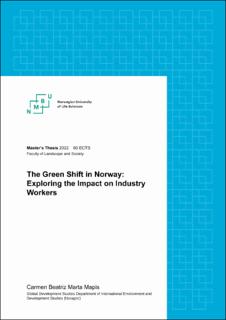| dc.description.abstract | Anthropogenic climate change is a reality that requires transformations. In Norway, the Green Shift represents that quest toward a low-carbon society. This process to tackle climate change will affect different industrial segments, namely the energy sector. This thesis investigates the challenges and opportunities for industry workers within the oil, gas, and processing industries.
Industry workers in Norway stand between different perspectives of what the Green Shift entails. On one hand, Norway's economic dependence on the oil and gas industries created a robust national intertwined relationship with hydrocarbons that currently employs 200.000 workers. The local legal framework regarding fossil fuels protects the future of extractive industries. This occurs despite the global negative impacts of fossil fuel production on climate. On the other hand, a new growing green sector poses opportunities for the industry workers by promising climate-friendly jobs, such as battery production.
This thesis studies Agder, Rogaland, and Oslo as locations impacted by the plans and development of a local battery Gigafactory, as well as locations with most workers from extractive industries.
By 2050, the limit to global warming should remain below 2 degrees Celsius, compared to pre-industrial levels. After joining the Paris Agreement, several emerging green sectors responded with industrial projects to address the increasing international demand to achieve those climate goals.
Norway tries to balance national interests between the fossil fuels industries and the new green ones. This duality creates discrepancies visible in the views of politicians, trade unions, workers, and investors that participated in this research. This study used qualitative methods based on 53 semi-structured interviews and document analyses. The results highlighted four main challenges for workers: growing inequality, labor precarity, less solidarity, and loss of identity connected to specific professions. The future of Norway’s industry workers will test its capacity to achieve a just transition and the ability of the trade unions to protect workers’ interests. | en_US |

